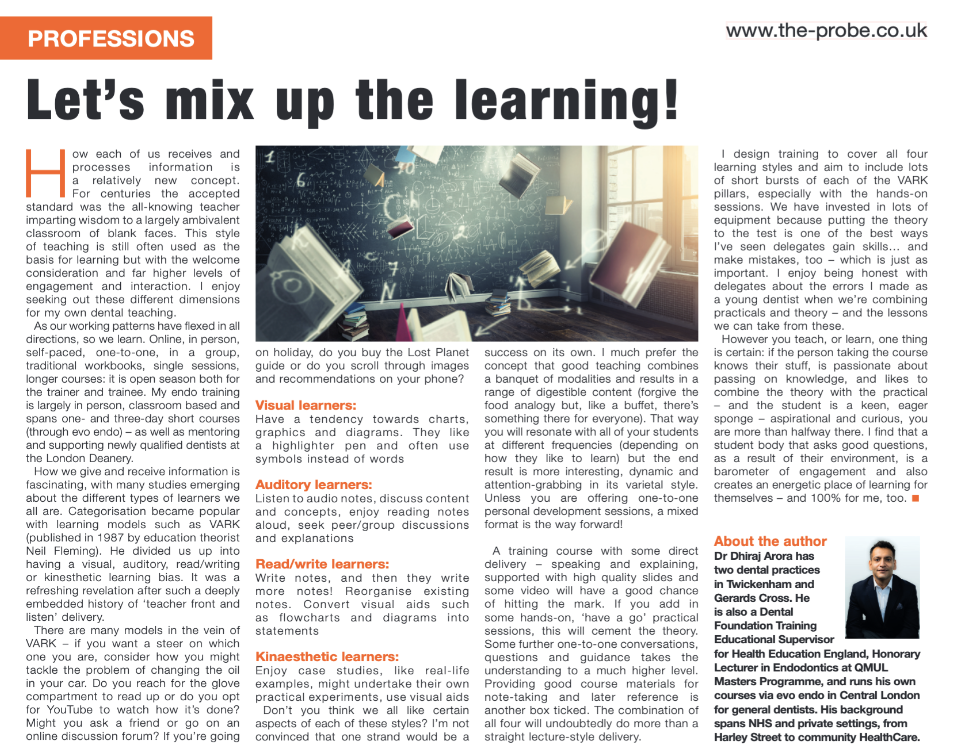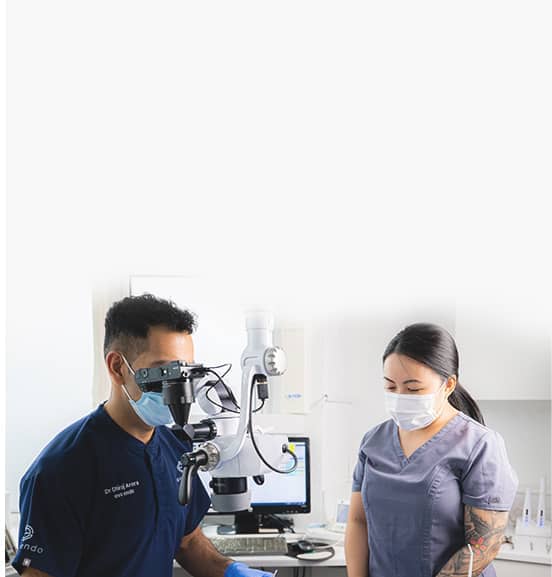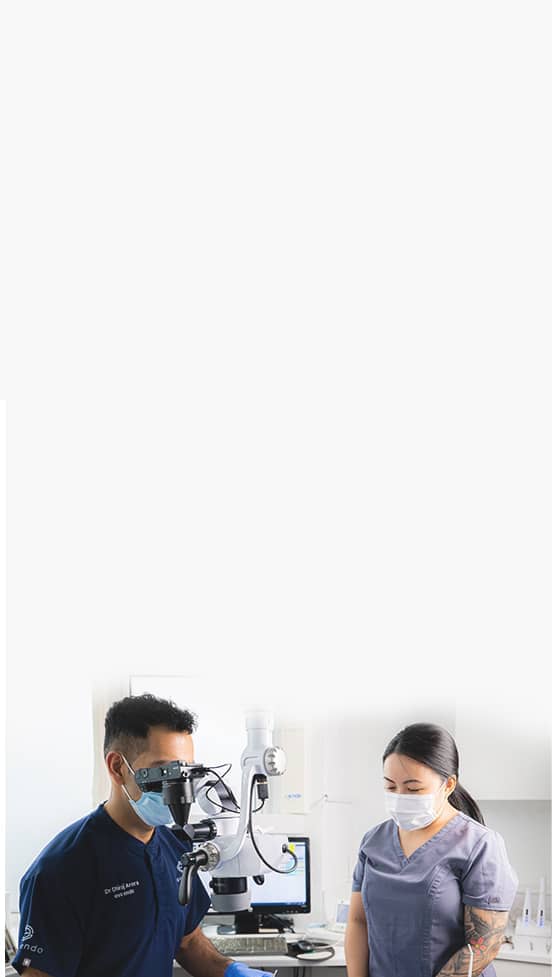
[Source: The Probe • July 2024]
How each of us receives and processes information is a relatively new concept. For centuries the accepted standard was the all-knowing teacher imparting wisdom to a largely ambivalent classroom of blank faces. This style of teaching is still often used as the basis for learning but with the welcome consideration and far higher levels of engagement and interaction. I enjoy seeking out these different dimensions for my own dental teaching.
As our working patterns have flexed in all directions, so we learn. Online, in person, self-paced, one-to-one, in a group, traditional workbooks, single sessions, longer courses: it is open season both for the trainer and trainee. My endo training is largely in person, classroom based and spans one and three day short courses (through evo endo) – as well as mentoring and supporting newly qualified dentists at the London Deanery.
How we give and receive information is fascinating with many studies emerging about the different types of learners we all are. Categorisation became popular with learning models such as VARK (published in 1987 by education theorist Neil Fleming). He divided us up into having a visual, auditory, read/writing or kinesthetic learning bias. It was a refreshing revelation after such a deeply embedded history of ‘teacher front and listen’ delivery.
There are many models in the vein of VARK – if you want a steer on which one you are, consider how you might tackle the problem of changing the oil in your car. Do you reach for the glove compartment to read up or do you opt for YouTube to watch how it’s done? Might you ask a friend or go on an online discussion forum? If you’re going on holiday, do you buy the Lost Planet guide or do you scroll through images and recommendations on your phone?
Visual learners:
Have a tendency towards charts, graphics and diagrams. They like a highlighter pen and often use symbols instead of words
Auditory learners:
Listen to audio notes, discuss content and concepts, enjoy reading notes aloud, seek peer/group discussions and explanations
Read/write learners:
Write notes, and then they write more notes! Reorganise existing notes. Convert visual aids such as flowcharts and diagrams into statements
Kinesthetic learners:
Enjoy case studies, like real-life examples, might undertake their own practical experiments, use visual aids
Don’t you think we all like certain aspects of each of these styles? I’m not convinced that one strand would be a success on its own. I much prefer the concept that good teaching combines a banquet of modalities and results in a range of digestible content (forgive the food analogy but, like a buffet, there’s something there for everyone). That way you will resonate with all of your students at different frequencies (depending on how they like to learn) but the end result is more interesting, dynamic and attention-grabbing in its varietal style. Unless you are offering one-to-one personal development sessions, a mixed format is the way forward!
A training course with some direct delivery – speaking and explaining, supported with high quality slides and some video will have a good chance of hitting the mark. If you add in some hands-on, ‘have a go’ practical sessions, this will cement the theory. Some further one-to-one conversations, questions and guidance takes the understanding to a much higher level. Providing good course materials for note-taking and later reference is another box ticked. The combination of all four will undoubtedly do more than a straight lecture-style delivery.
I design training to cover all four learning styles and aim to include lots of short bursts of each of the VARK pillars, especially with the hands-on sessions. We have invested in lots of equipment because putting the theory to the test is one of the best way I’ve seen delegates gain skills… and make mistakes too- which is just as important. I enjoy being honest with delegates about the errors I made as a young dentist when we’re combining practicals and theory – and the lessons we can take from these.
However you teach, or learn, one thing is certain… if the person taking the course knows their stuff, is passionate about passing on knowledge and likes to combine the theory with the practical – and the student is a keen, eager sponge – aspirational and curious; you are more than halfway there. I find that a student body that asks good questions, as a result of their environment, is a barometer of engagement and also creates an energetic place of learning for themselves – and 100% for me too.
Back to Blog

With practices in London and the South of England I am able to help your patients with dedicated and experienced endodontic care.
Read more

Aimed specifically at early career dentists, I can help with both the practical and patient care aspects of becoming a seriously good endodontist. Currently we have two courses running with dates set for 2023. Shake up your Shaping (1 day) and Endo Roots (3 days).
Read moreWe use cookies on our website. Some of them are essential, while others help us to improve this website and your experience.
Here you will find an overview of all cookies used. You can give your consent to whole categories or display further information and select certain cookies.
Essential cookies enable basic functions and are necessary for the proper function of the website.
| Name | |
|---|---|
| Provider | Owner of this website |
| Purpose | Saves the visitors preferences selected in the Cookie Box and other strictly functional behaviour of the web site |
| Host(s) | .evoendo.co.uk, evoendo.co.uk |
| Cookie Name | PHPSESSID,dmxlabs-kooke,cerber_groove,wordpress_* |
| Cookie Expiry | 1 Year |
Statistics cookies collect information anonymously. This information helps us to understand how our visitors use our website.
| Accept | |
|---|---|
| Name | |
| Provider | Google LLC |
| Purpose | Cookie by Google used for website analytics. Generates statistical data on how the visitor uses the website. |
| Privacy Policy | https://policies.google.com/privacy?hl=en |
| Cookie Name | _ga,_gat,_gid |
| Cookie Expiry | 2 Years |
| Accept | |
|---|---|
| Name | |
| Provider | |
| Purpose | Used to unblock Google Maps content. |
| Privacy Policy | https://policies.google.com/privacy?hl=en&gl=en |
| Host(s) | .google.com |
| Cookie Name | NID |
| Cookie Expiry | 6 Month |
| Accept | |
|---|---|
| Name | |
| Provider | |
| Purpose | Used to unblock Instagram content. |
| Privacy Policy | https://www.instagram.com/legal/privacy/ |
| Host(s) | .instagram.com |
| Cookie Name | pigeon_state |
| Cookie Expiry | Session |
| Accept | |
|---|---|
| Name | |
| Provider | Vimeo |
| Purpose | Collects information on the user's visits to the website, such as which pages have been read and offers best video quality based on determined visitor internet speed. |
| Privacy Policy | https://vimeo.com/privacy |
| Host(s) | .vimeocdn.com, fresnel.vimeocdn.com, player.vimeo.com |
| Cookie Name | vuid,sync_active,player |
| Cookie Expiry | 2 Years |
| Accept | |
|---|---|
| Name | |
| Provider | YouTube |
| Purpose | Used to unblock YouTube content. |
| Privacy Policy | https://policies.google.com/privacy?hl=en&gl=en |
| Host(s) | google.com |
| Cookie Name | NID,pref,VISITOR_INFO1_LIVE,CONSENT |
| Cookie Expiry | 6 Month |

